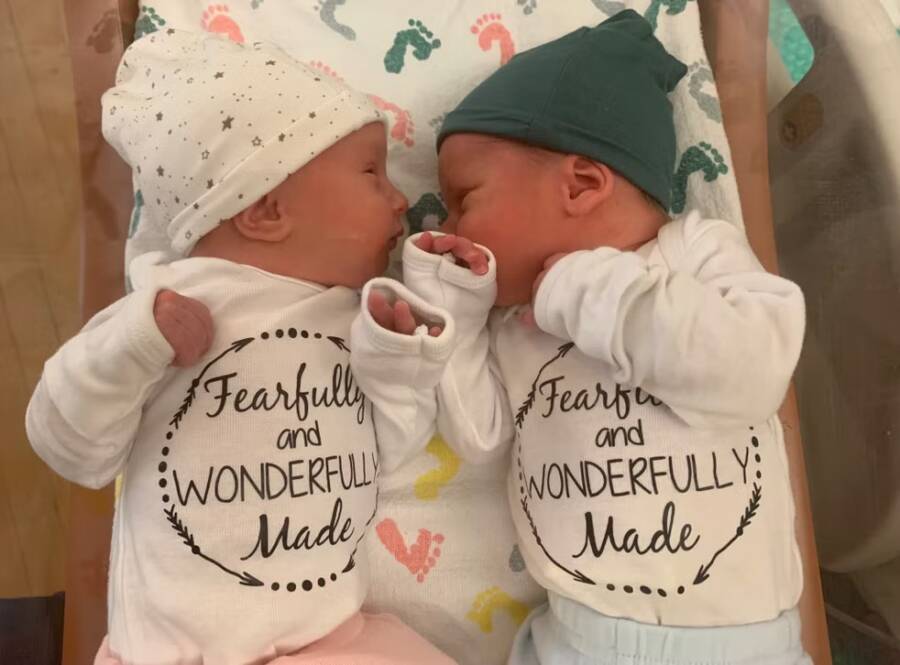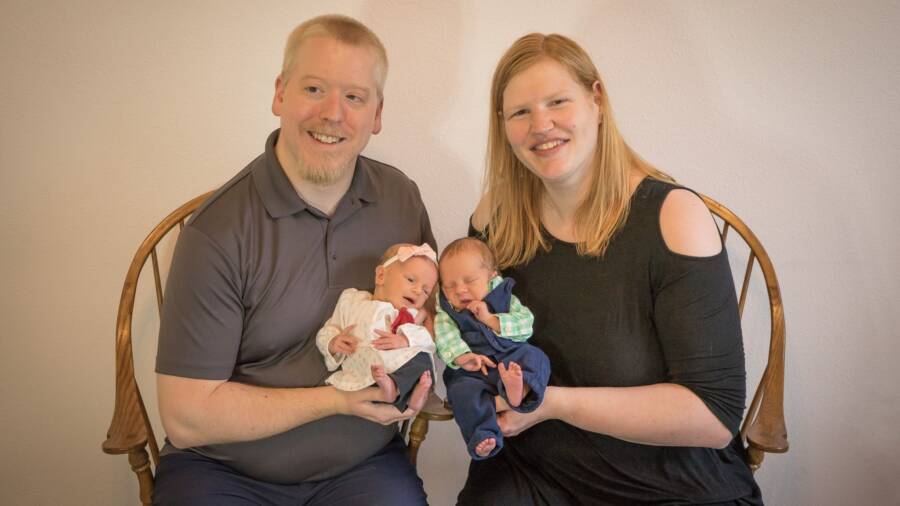Twins Lydia and Timothy Ridgeway were born on October 31, 2022 — but the embryos they were born from were frozen in April 1992.

NEDCLydia and Timothy Ridgeway, born October 31, 2022, to Philip and Rachel Ridgeway.
In April 1992, George H.W. Bush was America’s president, John Major was the Prime Minister of England, and Vanessa Williams’ “Save the Best for Last” was at the top of the Billboard Hot 100, supplanting Right Said Fred’s “I’m Too Sexy.”
It’s a time close enough to be fresh in the memory of many, and far off enough to make anyone who remembers those songs being on the radio feel old. It’s also when the embryos that formed the newly-born Lydia and Timothy Ridgeway were frozen.
Twins Lydia and Timothy Ridgeway were born on October 31, 2022, to parents Philip and Rachel Ridgeway of Oregon, 30 years after the twins’ embryos were frozen. As Philip put it, the entire experience is “mind-boggling,” according to CNN.
“I was five years old when God gave life to Lydia and Timothy, and he’s been preserving that life ever since,” Philip said. “In a sense, they’re our oldest children, even though they’re our smallest children.”
The couple has four other children between the ages of two and eight, none of whom were conceived through donors or in vitro fertilization (IVF).
“We’ve never had in our minds a set number of children we’d like to have,” Philip said. “We’ve always thought we’ll have as many as God wants to give us, and… when we heard about embryo adoption, we thought that’s something we would like to do.”
The embryos were originally donated in 1992 by a 34-year-old woman and a 50-year-old man for an anonymous couple, but for one reason or another, they remained frozen in liquid nitrogen nearly 200 degrees below freezing at a West Coast fertility lab until 2007.
They were then donated to the National Embryo Donation Center (NEDC), a faith-based non-profit organization in Knoxville, Tennessee, by the original couple, hoping that another couple else might be able to use them.
Medically, this process is known as “embryo donation.” When someone undergoes IVF, they can create more embryos than they use, which they can opt to have cryopreserved for future use either in birth research or, as in this case, donated to others looking to have children.
The NEDC requires a family assessment for all couples looking to adopt an embryo. “Couples,” they say, “must be a genetic male and a genetic female married for a minimum of 3 years.”

NEDCPhilip and Rachel Ridgeway show off the newest additions to their family.
Children born of embryo donations don’t share any genetic traits with the parents who raise them, but from a legal standpoint, the couple who “adopts” an embryo are the child’s parents.
The term “adoption” can be a bit confusing in this sense, as Dr. Sigal Klipstein tells CNN. Klipstein is a Chicago-based fertility specialist and chair of the American Society of Reproductive Medicine’s ethics committee.
“Adoption refers to living children,” Klipstein said. “It’s a legal process by which a parent-child relationship is created when it did not previously exist.” Embryo adoption, however, is “a way by which we take embryos from one couple or individual and then transfer them into another individual in order to build families.”
Referring to the procedure as “adoption” has also caused some controversy.
According to a 2016 report from the Ethics Committee of the American Society for Reproductive Medicine (ASRM), the “application of the term ‘adoption’ to embryos is inaccurate, is misleading, and could place burdens upon recipients and should be avoided.”
The ASRM states that the term is “misleading” as it “reinforces a conceptualization of the embryo as a fully entitled legal being, and may lead to a series of legal procedures associated with the adoption of born children that are not appropriate and that unjustly burden recipients.”
Regardless of the semantics of the term, the NEDC states that it has helped with the births of over 1,260 infants from donated embryos.
As The Independent reports, Rachel and Philip Ridgeway weren’t necessarily looking to set a record when they looked into embryo adoption. “We just wanted the ones that had been waiting the longest,” Philip said.
The Ridgeways specifically looked into embryos that fell into the “special consideration” category, meaning it had been difficult to find recipients for them. They also couldn’t see the date when the embryos were frozen, just the donor numbers. Naturally, they assumed a lower donor number meant that those embryos had been waiting the longest.
“Going into this, we knew that we could trust God to do whatever he had sovereignly planned and that their age really had no factor,” Rachel said. “It was just a matter of whether or not that was in God’s plans.”
After reading about these “mind-boggling” twins, learn about the “chimera” embryos scientists created in hopes of finding miracle cures. Then, read about five-year-old Lina Medina, the youngest mother in recorded history.





